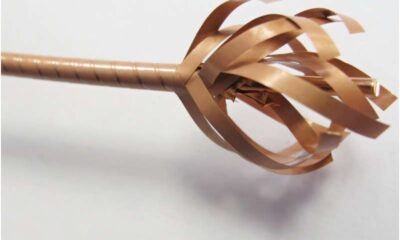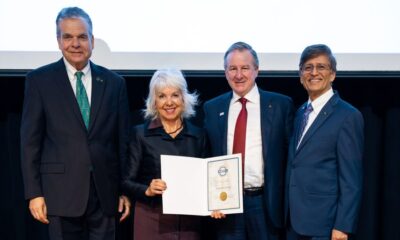Science
New Cable Design Enhances Superconducting Wire Efficiency

Researchers from the FAMU-FSU College of Engineering and Florida State University have developed an innovative cable design that addresses significant flaws in superconducting wires. This advancement, detailed in the peer-reviewed journal Superconductor Science and Technology, utilizes multiple strands of superconducting tape in a single cable structure, allowing for improved reliability in electrical systems.
When current travels through traditional wires, imperfections can disrupt the flow, forcing it to take a longer route. This can lead to inefficiencies and potential failures, posing challenges for manufacturers. The new cable design mitigates these issues by enabling the current to jump between strands when it encounters a defect, thereby maintaining a continuous flow of electricity. This approach promises to enhance the efficiency and reduce costs of superconducting wires, which have applications in electric motors, medical equipment, and fusion power plants.
Sastry Pamidi, interim director of the Center for Advanced Power Systems and chair of the Department of Electrical and Computer Engineering at Florida State University, highlighted the importance of industry collaboration in this research. He stated, “By partnering with Advanced Conductor Technologies, we support the development of a new, innovative idea and have a way to transition the technology quickly to applications.” This partnership aims to produce low-cost superconducting wire while minimizing the risk of equipment failure.
Advancements in Superconducting Technology
The research builds upon previous collaborations with Advanced Conductor Technologies based in Colorado. The team worked on a technology known as Conductor on Round Core (CORC) wire, which allows for the production of superconducting coils that utilize helium gas for cooling, rather than the more cumbersome liquid nitrogen. This adaptation offers engineers greater design flexibility, as helium remains gaseous over a wider temperature range.
The CORC wires are constructed by spiraling multiple superconducting tapes together without soldering. Instead, they rely on the pressure between the tapes, which facilitates electricity flow. This design not only enhances the wire’s flexibility and strength but also optimizes the use of materials, reducing waste.
Pamidi explained the significance of this research, stating, “We are not just doing research for the sake of doing research. It has an impact. Our work helps companies develop products.” By providing scientific expertise and advanced facilities, the researchers play a critical role in enhancing manufacturing processes for partner companies.
The collaboration also extends to SuperPower Inc., a New York-based manufacturer of high-temperature superconducting tape. The combined efforts of FSU and industry partners have addressed various technical challenges that have historically hindered the commercial viability of superconducting cables.
The Broader Impact of Superconducting Wires
Superconducting wires are crucial in a wide array of applications, including electrical motors, electric aircraft, power transmission lines, and high-energy physics research. They operate without electrical resistance, making them more efficient than conventional wires. Yet, manufacturing these wires is complex, often resulting in defects that can hinder performance.
Historically, the solution to defects involved soldering together multiple wire segments to create a long, uninterrupted length. The new cable configuration, developed through the efforts of FSU and its collaborators, promises to provide the benefits of superconducting wires at a lower cost while minimizing the impact of defects.
Yifei Zhang, vice president of research and development at SuperPower, expressed enthusiasm for the project, noting that the innovative cable structure demonstrated performance on par with nearly defect-free wires. “This result can change the way wire production yield is calculated, which will lead to a significant reduction in wire cost,” he added.
As the field of superconductivity continues to evolve, researchers like Pamidi are exploring new technologies that enable superconducting wires to function at higher temperatures, potentially simplifying their application. Current high-temperature superconducting wires can operate effectively at temperatures as high as 77 kelvins, making them more accessible for various industries.
The advancements in superconducting wire technology not only enhance efficiency but also have the potential to transform multiple sectors, paving the way for more sustainable and innovative solutions in energy and transportation.
-

 Technology5 months ago
Technology5 months agoDiscover the Top 10 Calorie Counting Apps of 2025
-

 Technology3 weeks ago
Technology3 weeks agoOpenAI to Implement Age Verification for ChatGPT by December 2025
-

 Health3 months ago
Health3 months agoBella Hadid Shares Health Update After Treatment for Lyme Disease
-

 Health3 months ago
Health3 months agoAnalysts Project Stronger Growth for Apple’s iPhone 17 Lineup
-

 Health3 months ago
Health3 months agoErin Bates Shares Recovery Update Following Sepsis Complications
-

 Technology5 months ago
Technology5 months agoDiscover How to Reverse Image Search Using ChatGPT Effortlessly
-

 Technology3 months ago
Technology3 months agoElectric Moto Influencer Surronster Arrested in Tijuana
-

 Technology2 months ago
Technology2 months agoDiscover 2025’s Top GPUs for Exceptional 4K Gaming Performance
-

 Technology5 months ago
Technology5 months agoMeta Initiates $60B AI Data Center Expansion, Starting in Ohio
-

 Technology5 months ago
Technology5 months agoRecovering a Suspended TikTok Account: A Step-by-Step Guide
-

 Health5 months ago
Health5 months agoTested: Rab Firewall Mountain Jacket Survives Harsh Conditions
-

 Lifestyle5 months ago
Lifestyle5 months agoBelton Family Reunites After Daughter Survives Hill Country Floods





















